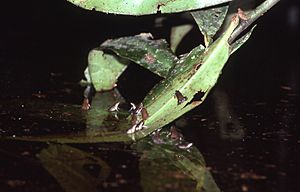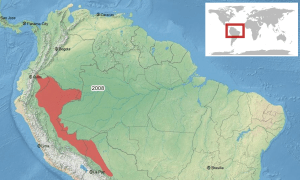Dotted humming frog facts for kids
Quick facts for kids Dotted humming frog |
|
|---|---|
 |
|
| Conservation status | |
| Scientific classification | |
 |
|
| Synonyms | |
|
Engystoma ventrimaculata Andersson, 1945 |
The Chiasmocleis ventrimaculata, also called the dotted humming frog, is a tiny frog from the Microhylidae family. You can find it in countries like Bolivia, Brazil, Colombia, Ecuador, and Peru. These frogs love to live in warm, wet places. This includes lowland forests, swamps, and temporary freshwater marshes.
Contents
Meet the Dotted Humming Frog
The dotted humming frog is a small frog. It grows to about 2 centimeters long. That's less than an inch! These frogs are active at night. They have narrow, pointed heads and slim bodies. Their back feet do not have webbing.
During the day, these frogs usually stay underground. They often live in burrows with tarantulas. When evening comes, they come out to look for food. Several frogs, usually 1 to 4, might share one tarantula burrow. They don't seem to mind sharing their space.
Baby Frogs: Tadpoles
Baby dotted humming frogs are called tadpoles. They are about 1.7 centimeters long. Their bodies are flat and wide, especially near their eyes. They have large eyes that are far apart. Their snout is broad and rounded. These tadpoles do not have nostrils.
Their mouths are small and at the very front. The upper lip is big and fleshy. These tadpoles don't have hard mouthparts. They are usually a pale brown color.
How They Find Food
These frogs are careful when they leave their burrows at dusk. They use a "sit-and-wait" method to find food. This means they wait for food to come to them. They usually stay very close to their burrow entrance. They will dart back inside quickly when they are done eating.
Where Dotted Humming Frogs Live
Dotted humming frogs live among leaf litter and plants. They stay close to the ground. During the rainy season, they lay their eggs. They use temporary ponds that form from rainwater. We don't know much about what they do in the dry season.
These frogs live in different parts of the Amazon rainforest. Most are found in western Amazon areas. This includes Colombia, Ecuador, Peru, Bolivia, and western Brazil.
Frog Food: What They Eat
The dotted humming frog mainly eats ants. They also enjoy eating tiny mites.
Life Cycle of the Dotted Humming Frog
Dotted humming frogs lay their eggs in large temporary ponds. These ponds appear during the rainy season. A female frog can lay about 400 eggs at once! The eggs hatch very quickly, in about 36 hours.
When they first hatch, the tadpoles stay still. They float vertically in the water, head up. After 24 hours, they tilt to a 45-degree angle. They still don't move much. After 48 hours, they start to move around. The young froglets leave the water after about three weeks. These tadpoles are a pale brown color.
You can see these tadpoles in shallow water, about 60 centimeters deep. They often gather in large, still groups. Each tadpole faces the same direction. Their main food is tiny bits of dead leaves and insects.
Mating and Reproduction
Dotted humming frogs like to breed in temporary forest ponds. During mating season, their behavior changes. They become active both day and night. The male frogs will start to "sing" or chorus.
These frogs are "explosive breeders." This means many frogs gather to breed at once. During the rainy season, you can find hundreds of them together. After the first big rainfall, male frogs appear in ponds. They start calling. They first call from the land, hidden in leaf litter. Later, they call from floating leaves and twigs.
Females arrive at the ponds by nightfall. The calling continues all through the next day and night. By the third morning, the frogs leave the pond. The pond will be full of egg clutches. There are usually many more males than females. Breeding is most active at the start of the rainy season.
How Males Attract Females
Male frogs make special calls during breeding season. These calls are a series of short pulses. They make about 7 to 8 pulses per second. The sound is high-pitched. Males puff up their vocal sacs. This helps females hear their calls better.
Mating happens mostly from 8:00 PM to 4:00 AM. Females are drawn to the males' calls. They move into the water towards the males. The males then jump into the water. They perform "amplexus," which is how frogs mate. Males do not call during amplexus. This mating embrace can last up to 30 minutes.
Parental Care
Dotted humming frogs lay their eggs on the surface of these ponds. Because so many frogs breed at once, thousands of eggs can be laid. After hatching, the tadpoles stay near the pond shores. They gather in groups. This helps them protect themselves from water predators.
Social Life of the Frog
These frogs don't seem to care about living in groups. They are not territorial. They have been seen sharing spider burrows with other frogs. However, a frog will usually stick to the burrow it first chose. They don't switch burrows. Even if the tarantula leaves, the frogs might still live there.
A Special Friendship: Frogs and Spiders
The dotted humming frog is famous for its special relationship. It lives with a type of burrowing tarantula. Scientists debate if this is a "mutualistic" or "commensal" relationship.
- Mutualism means both animals help each other.
- Commensalism means one animal benefits, but the other is not helped or harmed.
It's clear the frog benefits a lot. The tarantula protects the frog from predators. The frog can also eat leftover food from the spider's meals. The burrow gives the frog shelter from weather changes.
Scientists think the tarantula might also benefit. These frogs are good at eating ants. This could help protect the tarantula's eggs from ants. Some ideas suggest the frog's skin might have chemicals that keep spider eggs healthy. Also, if the frogs attract predators, the tarantula might get more food by eating those predators.
Interestingly, these tarantulas attack other frog species. But they never attack the dotted humming frog. This suggests the dotted humming frog has a special feature. It might be a chemical on its skin. This chemical tells the tarantula that the frog is not food.
Who Hunts the Dotted Humming Frog?
Predators
Many animals hunt dotted humming frogs. As tadpoles, they are eaten by freshwater crabs and insect larvae. Turtles also feed on them. Adult frogs are hunted by spiders. Fish like Hoplias malabaricus and Synbranchus marmoratus eat both frogs and tadpoles. Even caimans hunt these frogs.
Many bird species also eat them. These include Capped Herons, Sunbitterns, and Double-toothed Kites. Snakes seem to be the main predators of these frogs. Some bats might also try to eat them during mating calls.
How They Protect Themselves
The dotted humming frog has special camouflage. Their skin color helps them look like fallen leaves. This helps them hide from predators. When they feel threatened, they jump a short distance. They land with their legs stretched out stiffly. They can stay in this stiff position for up to 4 minutes.


